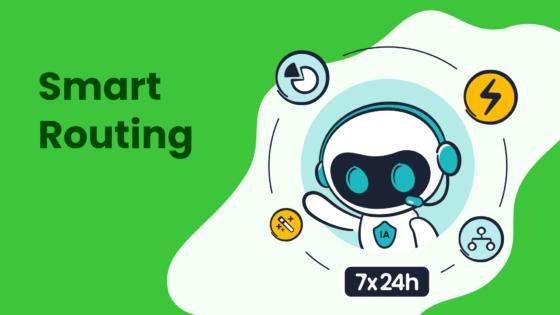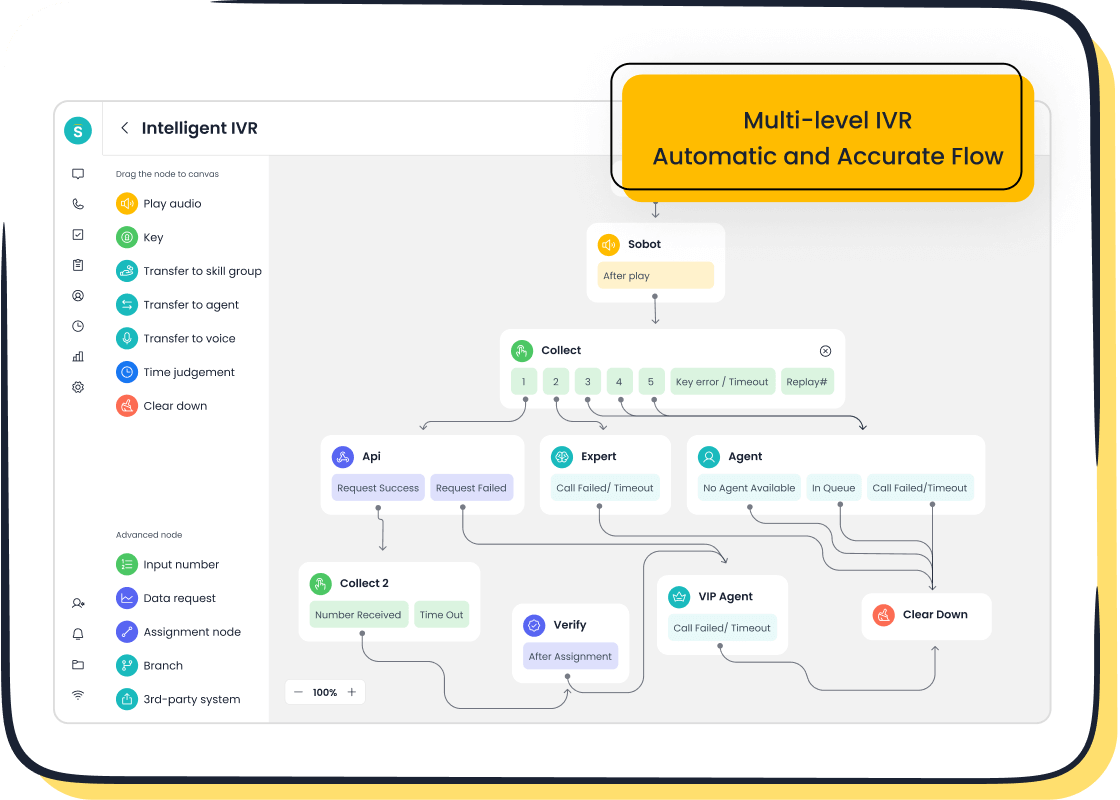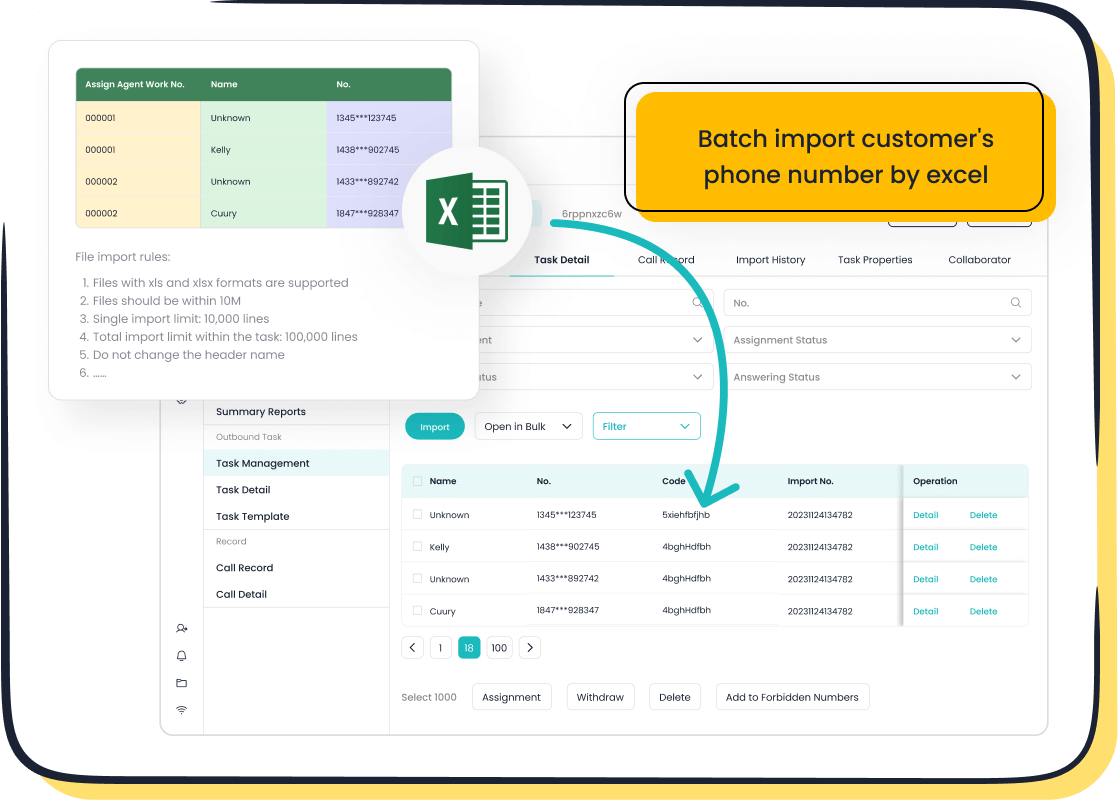What is a Voice User Interface in Conversational AI

Voice User Interface (VUI) lets you interact with systems using voice commands, making technology feel more human. Unlike traditional interfaces, VUIs allow you to complete tasks faster and more naturally, as if you were speaking to a friend. This innovation has transformed Conversational AI by enabling seamless, voice-driven interactions.

Industries like retail and healthcare increasingly adopt VUIs to improve customer engagement. For example, Sobot's Voice/Call Center uses AI-powered Voicebots to deliver efficient, personalized support. These tools enhance customer service by offering intuitive, hands-free solutions that adapt to your needs.
The Evolution of Voice User Interfaces (VUIs)
From Traditional Interfaces to Voice-Driven Solutions
Early user interfaces: Command-line and graphical interfaces
The journey of user interfaces began with command-line systems in the 1950s. These systems required users to input text commands, making them less accessible to non-technical individuals. Over time, graphical user interfaces (GUIs) emerged, introducing visual elements like icons and windows. GUIs revolutionized how people interacted with computers by making technology more intuitive and user-friendly. However, both command-line and graphical interfaces relied heavily on manual input methods, limiting their convenience.
The shift toward voice-driven interactions
The introduction of Voice User Interfaces (VUIs) marked a significant shift in how people interact with technology. Early milestones included the development of Audrey by Bell Labs in the 1950s, which could recognize spoken digits. By the 1980s, Interactive Voice Response (IVR) systems allowed users to navigate menus using voice commands. Today, AI-powered assistants like Siri and Google Assistant have made VUIs more conversational and accessible. These advancements enable you to interact with devices naturally, using speech instead of typing or clicking.
The Role of VUIs in Modern Customer Service
Meeting the demand for hands-free, intuitive technology

Modern customer service increasingly relies on VUIs to meet the growing demand for hands-free solutions. Call centers, for example, use automated speech recognition in their IVR systems to greet callers and provide menu options. This approach enhances customer interactions by making them more conversational and efficient. Businesses like Sobot leverage AI-powered Voicebots to deliver personalized support, ensuring that customers receive quick and accurate assistance.
Advances in speech recognition and natural language processing (NLP)
Recent advancements in speech recognition and NLP have transformed VUIs into powerful tools for customer service. These technologies allow systems to understand complex language patterns, enabling multi-turn conversations and learning from user interactions. Modern VUIs can interpret variations in pitch, tone, and speed, making interactions feel more human-like. For instance, Sobot's Voice/Call Center uses AI to recognize customer intent, ensuring seamless communication and improved satisfaction.
How Voice User Interfaces Work in Conversational AI
Core Components of a VUI
Speech recognition systems

Speech recognition systems form the foundation of a Voice User Interface (VUI). These systems capture your spoken words and convert them into text using Automatic Speech Recognition (ASR). Advanced programming and specialized tools ensure high accuracy, even in noisy environments. For example, Sobot's Voice/Call Center uses AI-powered Voicebots to recognize customer intent, enabling seamless communication. This technology allows businesses to handle complex queries efficiently.
Natural language understanding (NLU) modules
Natural Language Understanding (NLU) modules interpret the meaning behind your words. They analyze context, tone, and intent to determine the appropriate response. NLU relies on AI and machine learning to improve over time, making interactions more natural. For instance, when you ask a Voicebot about order status, the NLU module ensures the system understands your request and provides accurate information.
Text-to-speech (TTS) engines
Text-to-Speech (TTS) engines convert text-based responses into spoken words. This component ensures that the system communicates with you in a clear and human-like manner. Sobot's Voice/Call Center integrates TTS technology to deliver personalized responses, enhancing customer satisfaction. By combining TTS with other components, businesses can create a conversational experience that feels intuitive and engaging.
The Process of Voice Interaction
Capturing and processing voice input
The process begins when you speak into a microphone or audio device. The system captures your voice and uses ASR to transcribe it into text. Next, NLU interprets the text to understand your intent. Interactive Voice Response (IVR) systems then route your request to the appropriate function. This ensures that your query is handled efficiently, whether it involves retrieving information or completing a task.
- Voice input is captured and analyzed for recognizable words.
- The system interprets the context and intent of your request.
- It maps your input to the correct action or response.
Generating and delivering voice responses
Once the system understands your request, it generates a response. TTS technology converts this response into speech, which is then delivered back to you. For example, if you ask about store hours, the system retrieves the information and communicates it verbally. This process ensures a smooth and interactive experience, making it easier for you to get the help you need.
Integration with Sobot's Voice/Call Center
How Sobot's AI-powered Voicebot enhances VUI functionality

Sobot's Voice/Call Center takes VUI functionality to the next level with its AI-powered Voicebot. This tool uses advanced speech recognition and NLU to understand customer queries accurately. It also integrates seamlessly with existing systems, ensuring a unified workspace for agents. By automating routine tasks, Sobot's Voicebot allows agents to focus on more complex issues, improving overall efficiency.
The role of machine learning in improving VUI performance
Machine learning plays a crucial role in enhancing VUI performance. It enables systems to learn from past interactions, improving accuracy and response times. Sobot's Voice/Call Center leverages machine learning to refine its Voicebot capabilities. Over time, the system becomes better at understanding diverse accents, languages, and customer needs, ensuring a superior user experience.
Benefits of Voice User Interfaces in Customer Service
Accessibility and Inclusivity
Enabling technology use for people with disabilities
Voice User Interfaces (VUIs) open doors for individuals with disabilities by providing an intuitive way to interact with technology. For those with mobility or dexterity challenges, VUIs eliminate the need for physical input devices. People with visual impairments benefit from audio-based interfaces, allowing them to access services without relying on screens. Additionally, VUIs simplify interactions for individuals with cognitive disabilities by reducing the complexity of traditional interfaces. These features make VUIs a valuable tool for creating a more inclusive digital environment.
Bridging the digital divide for non-tech-savvy users
VUIs help non-tech-savvy users engage with technology effortlessly. In low-resource environments, they provide access to information and services without requiring advanced technical skills. Platforms like Kasadaka have demonstrated how voice-based systems can deliver localized content to underserved populations. By enabling natural, conversational interactions, VUIs make technology more approachable for everyone, regardless of their technical expertise.
Convenience and Productivity
Hands-free operation for multitasking
VUIs allow you to perform tasks without using your hands, making them ideal for multitasking. Whether you're driving, cooking, or working, you can interact with systems through voice commands. This hands-free functionality enhances productivity by letting you focus on other activities while completing tasks like checking order statuses or scheduling appointments.
Faster and more natural interactions
With VUIs, you can complete tasks quickly and naturally. For example, ordering food or booking an appointment becomes seamless through conversational voice commands. These systems also provide timely notifications, such as reminders or alerts, ensuring you stay informed without unnecessary effort. By engaging in natural conversations, VUIs create a user-friendly experience that feels intuitive and efficient.
Enhanced Customer Experiences with Sobot
Personalized and efficient customer service

Sobot's Voice/Call Center leverages AI-powered Voicebots to deliver personalized customer service. These Voicebots understand your intent and provide tailored responses, ensuring a smooth interaction. For instance, they can assist with multilingual support or route your call to the right agent, saving time and improving satisfaction. This level of personalization enhances engagement and builds trust with customers.
24/7 availability through Sobot's Voice/Call Center
Sobot's Voice/Call Center ensures round-the-clock availability, allowing you to access support whenever needed. The AI-powered Voicebots handle routine inquiries efficiently, freeing up agents to focus on complex issues. This continuous availability not only improves customer satisfaction but also boosts operational efficiency for businesses. With Sobot, you can rely on consistent, high-quality service at any time.
Challenges of Implementing Voice User Interfaces
Technical Challenges
Accuracy issues in noisy environments

Voice recognition systems often struggle in noisy settings. Background sounds, poor microphone quality, or overlapping voices can reduce accuracy. For example, a customer calling from a busy street may find it difficult to communicate effectively with a Voicebot. These challenges require advanced noise-cancellation technologies and robust algorithms to filter out irrelevant sounds. Sobot's Voice/Call Center addresses this by leveraging AI-powered Voicebots that excel in recognizing speech even in less-than-ideal conditions, ensuring smoother interactions.
Language and accent recognition challenges
Accents and dialects present another hurdle for VUIs. Conventional systems may misinterpret non-native accents, such as Chinese or Spanish-accented English, leading to errors. Additionally, variations in vocabulary and pronunciation complicate the process. To overcome this, VUIs must incorporate diverse datasets during training. Sobot's Voice/Call Center uses machine learning to improve its understanding of different accents and languages, ensuring accurate responses for a global audience.
Privacy and Security Concerns
Ethical concerns around voice data collection
Voice data collection raises significant ethical questions. Many users worry about being recorded without consent, as highlighted by a Voicebot.ai survey where 33% of U.S. adults cited this fear as a barrier to adopting voice assistants. Issues like cultural biases and compliance with regulations, such as the Children’s Online Privacy Protection Act (COPPA), further complicate matters. Transparent policies and clear communication about data usage can help address these concerns.
Ensuring secure data transfer in VUI systems
Data security is critical for VUIs. Without proper safeguards, sensitive information could be intercepted or misused. Strong encryption, robust authentication methods, and regular security updates are essential to protect user data. Sobot's Voice/Call Center ensures secure data transfer through encrypted communication channels, providing peace of mind for businesses and their customers.
Resource Intensity
High computational and energy requirements
Developing and maintaining VUIs demands significant computing power. Processing voice data and executing commands in real-time require advanced hardware and software. This can lead to high energy consumption, making it less sustainable. Companies like Sobot optimize their systems to balance performance and efficiency, ensuring reliable service without excessive resource use.
Costs of developing and maintaining VUIs
Building a VUI involves substantial investment. Skilled professionals are needed to design conversational systems, while ongoing maintenance adds to the expense. Despite these costs, the benefits of improved customer engagement and operational efficiency often outweigh the initial investment. Sobot's Voice/Call Center offers a cost-effective solution through its SaaS model, making advanced VUI technology accessible to businesses of all sizes.
Real-World Applications of VUIs in Virtual Assistants and Beyond
Customer Service and Support with Sobot
Automating call center operations with Sobot's Voice/Call Center
You can transform your call center operations with VUIs by automating routine tasks. Modern IVR systems powered by VUIs allow callers to interact using conversational language instead of pressing buttons. These systems handle over 60% of call volume, reducing the workload for human agents. Sobot's Voice/Call Center takes this further with its AI-powered Voicebot, which recognizes customer intent and routes calls efficiently. This automation ensures faster resolutions and frees agents to focus on complex issues, improving overall productivity.
Enhancing customer satisfaction with quick responses
VUI technology enhances customer satisfaction by enabling hands-free and eyes-free interactions. You can perform tasks like retrieving information or initiating transactions effortlessly. Sobot's Voice/Call Center ensures quick responses through its intelligent routing and multilingual support. For example, customers can resolve queries without waiting for an agent, even during peak hours. This convenience builds trust and ensures a seamless experience.
Smart Home and IoT Integration
Controlling appliances through voice commands
Voice User Interfaces (VUIs) make managing smart home devices effortless. You can control appliances like lights, thermostats, and locks using simple voice commands. This hands-free interaction is especially helpful for multitasking or for individuals with mobility challenges. VUIs also enhance efficiency by allowing you to complete tasks faster than traditional methods. For instance, adjusting room temperature becomes as easy as saying, "Set the thermostat to 72 degrees."
Integration with IoT ecosystems
VUIs seamlessly integrate with IoT ecosystems, creating a connected living environment. You can manage multiple devices through a single interface, simplifying your daily routines. For example, a VUI can synchronize your smart speaker with other devices, enabling automated actions like turning off lights when you leave the house. This interconnected system not only saves time but also enhances convenience.
Healthcare and Accessibility
Assisting patients with voice-enabled tools
In healthcare, VUIs empower medical professionals and patients alike. Doctors can access patient records or dictate notes using voice commands, improving efficiency. Patients benefit from voice-enabled tools that provide personalized health information or medication reminders. For example, a VUI can help you schedule appointments or track your health metrics, ensuring better care management.
Supporting elderly and disabled individuals
VUIs promote independence for elderly and disabled individuals by simplifying daily tasks. You can use voice commands to manage household appliances, set reminders, or communicate with loved ones. These interfaces also assist with clinical needs, such as medication schedules or exercise routines. By enhancing accessibility, VUIs improve quality of life and foster greater autonomy.
Retail and E-commerce
Voice shopping and personalized recommendations
Voice User Interfaces (VUIs) have transformed how you shop online. By integrating voice assistants into e-commerce platforms, businesses now offer a seamless, hands-free shopping experience. You can search for products, check prices, and even complete purchases using natural language commands. This approach eliminates the need for typing or navigating complex menus, making the process faster and more intuitive.
For example, voice commerce allows you to manage transactions effortlessly. You can say, "Order a pair of running shoes," and the system will guide you through the process. VUIs also provide personalized recommendations by analyzing your preferences and past purchases. This creates a tailored shopping experience that strengthens your connection with the brand.
- Voice shopping offers a non-contact, convenient way to browse and buy.
- It simplifies the purchasing process, enhancing your overall experience.
- Personalized suggestions make it easier to find what you need, saving time and effort.
Sobot's Voice/Call Center can integrate with e-commerce platforms to enhance these capabilities. Its AI-powered Voicebot understands customer intent and delivers accurate responses, ensuring a smooth and engaging shopping journey.
Streamlining customer interactions in online platforms
VUIs streamline your interactions on online platforms by reducing friction at every touchpoint. Instead of navigating through multiple pages, you can use voice commands to get instant answers or complete tasks. This hands-free and eyes-free approach enhances convenience, especially when multitasking.
For instance, you might ask, "What’s the status of my order?" and receive an immediate update. VUIs also leverage real-time data to provide contextual and personalized responses. This ensures that your experience feels tailored to your needs.
- They improve accessibility for users with disabilities or language barriers.
- Natural conversation patterns make the technology easy to use, even for beginners.
- Faster resolutions through voice commands reduce waiting times and enhance satisfaction.
Sobot’s Voice/Call Center excels in this area by offering multilingual support and intelligent call routing. These features ensure that your queries are resolved quickly and efficiently, making online interactions more enjoyable and productive.
Voice User Interface (VUI) has revolutionized how you interact with technology, making communication more natural, efficient, and inclusive. By enabling hands-free operations and personalized responses, VUIs enhance accessibility and productivity across industries. Sobot's Voice/Call Center exemplifies these benefits by integrating AI-powered Voicebots, multilingual support, and intelligent call routing to deliver exceptional customer service.
Looking ahead, VUIs will continue to shape Conversational AI with advancements like real-time language translation, voice biometrics, and emotional intelligence. These innovations will improve security, personalization, and interaction quality. As voice analytics and conversational commerce grow, VUIs will redefine customer contact solutions, offering seamless and intelligent experiences.
FAQ
What is a Voice User Interface (VUI)?
A Voice User Interface (VUI) allows you to interact with technology using voice commands. It eliminates the need for manual input, making tasks faster and more natural. For example, Sobot's Voice/Call Center uses VUIs to provide seamless, hands-free customer service through AI-powered Voicebots.
How does Sobot's Voice/Call Center improve customer service?
Sobot's Voice/Call Center enhances customer service by automating routine tasks with AI-powered Voicebots. It offers features like multilingual support, intelligent call routing, and 24/7 availability. These tools ensure faster resolutions and personalized interactions, improving customer satisfaction and operational efficiency.
Can VUIs handle multiple languages?
Yes, modern VUIs, like those in Sobot's Voice/Call Center, support multiple languages. They use advanced Natural Language Processing (NLP) to understand and respond accurately in different languages. This feature makes VUIs ideal for businesses with a global customer base.
Are VUIs secure for handling sensitive information?
Yes, VUIs can securely handle sensitive data when equipped with encryption and robust authentication methods. Sobot's Voice/Call Center ensures secure data transfer through encrypted communication channels, protecting your information during interactions.
What industries benefit most from VUIs?
Industries like retail, healthcare, and customer service benefit significantly from VUIs. For instance, Sobot's Voice/Call Center helps e-commerce platforms streamline customer interactions, while healthcare providers use VUIs for appointment scheduling and medication reminders.
See Also
Comparative Analysis Of Leading Interactive Voice Response Tools
Understanding The Functionality Of IVR Voice Recognition Systems
Comparing The Best Voice Of Customer Software Solutions
Reviewing The Best Automated Voice Calling Software For 2024
